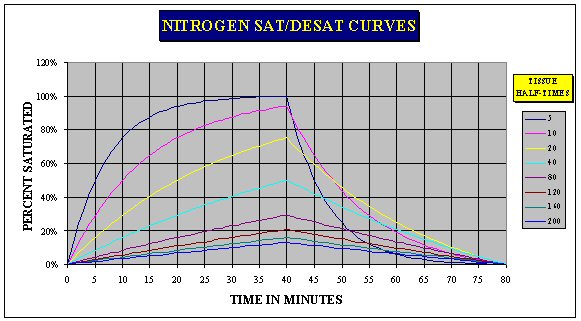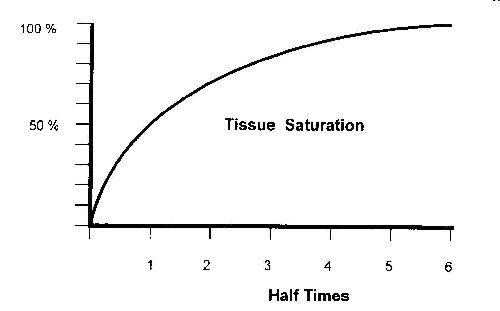Half times are a common concept in science. The most famous use of half times is in relation to nuclear materials where the half time is the time it takes a radioactive substance to decay to half of its current size. This is exactly the same concept applied to the uptake of Nitrogen by a tissue compartment. The half time of a compartment is the time it takes for the compartment to become half saturated, or if we are ascending to become half desaturated.
So if we consider a compartment with a half time of 5 minutes this means that compartment will become 50% saturated within 5 minutes. It will then take a further 5 minutes for the compartment to move from the current state to half way to saturation, i.e. 75%. The table below shows the progression of the tissue saturation at 5 minute intervals.
5 min 50%
10 min 75%
15 min 87.5%
20 min 93.75%
25 min 96.88%
30 min 98.44%
We can see from this that the largest movement takes place during the first half time period, each subsequent half time period then sees a smaller and smaller change. If we draw a graph of gas uptake over time we can see a smooth line that initially shoots up but then gets ever shallower as it reached 100%.
Mathematically the tissue will never reach 100% as it only moved half of the way from where it is towards 100% at each stage so it takes smaller and smaller steps towards its goal but always has the other half of the last step to cover. However, for practical purposes, after 6 periods we can consider the tissue saturated as it is at 98.44% saturation and after 24 hours we would consider the tissue to be completely saturated.
Each compartment will saturate at a different rate. As we have seen after 5 minutes the 5 min tissue is 50% saturated but the 10 min tissue will take 10 minutes to become 50% saturated and so on. This means that each of the tissues will have a different level of saturation with the fast tissues absorbing gas and moving towards saturation faster than the slow tissues. However, as the diver ascends and the pressure is reduced the fast tissues will also release inert gas faster as the half time also refers to the time it takes to release 50% of the absorbed gasses. This means that fast tissues will also release gases faster then slow tissues.

From the graph above we can see the behaviour of a number of compartments when considered together. As we have seen above the 5 min compartment is 50% saturated after 5 minutes, at 10 minutes it is 75 % saturated and so on until 30 minutes or 6 half-time periods it is effectively saturated (98.44%). The 10 min compartment is 50% saturated after 10 minutes. After 40 minutes the compartment is not yet saturated as this has only been 4 half time periods. It would require 6 half-time periods (60 minutes) for this compartment to become effectively saturated. The 40 min compartment is at 50% saturation at 40 minutes but all of the slower compartments; 80, 120, 160 and 200 min, are less then 50% saturated.
At 40 minutes the pressure is released and the compartments start to desaturate. The 5 min compartment was the most saturated but as it desaturates equally fast the level of saturation quickly drops to below that of the 10 min compartment and soon drops below the other compartments until at time 60 minutes, 20 minutes after the pressure was released, the 5 min compartment is less saturated than all of the other compartments. The 10 min compartment also drops quickly so that at 48 mins it drops below that of the 20 min compartment.






